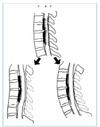References
1. Tsukimoto H. A case report : Autopsy of syndrome of compression of spinal cord owing to ossification within spinal canal of cervical spine. Arch Jpn Chir 1960. 291003–1007.
2. Hosoda Y, Yoshimura Y, Higaki S. A new breed of mouse showing multiple osteochondral lesions-twy mouse. Ryumachi 1981. 21Suppl. 157–164.
3. Nakamura I, Ikegawa S, Okawa A, Okuda S, Koshizuka Y, Nakamura Y, et al. Association of the human NPPS gene with ossification of the posterior longitudinal ligament of the spine (OPLL). Hum Genet 1999. 104492–497.
4. Youmans JR. Youmans Neurological surgery 1996. 4edth ed. Philadelphia: WB Saunders; 2328–2342.
5. Abe H, Tsuru M, Ito T, Iwasaki Y, Koiwa M. Anterior decompression for ossification of the posterior longitudinal ligament of the cervical spine. J Neurosurg 1981. 55108–116.
6. Rozario RA, Levine H, Stein BA. Cervical myelopathy and radiculopathy secondary to ossification of posterior longitudinal ligament. Surg Neurol 1978. 1017–20.
7. Hirabayashi K, Toyama Y, Chiba K. Expensive laminoplasty for myelopathy in ossification of the longitudinal ligament. Clin Orthop 1999. 35935–48.
8. Keiji K, Teiji T, Takashi Y. Spinous process-splitting laminoplasty with an extended foraminotomy for cervical myelopathy. Neurosurgery 1995. 37430–435.
9. Seichi A, Takeshita K, Ohishi I, Kawaguchi H, Akune T, Nakamura K, et al. Long-term results of double-door laminoplasty for cervical stenotic myelopathy. Spine 2001. 26479–487.
10. Yonenobu K, Fuji T, Ono K, Okada K, Yamamoto T, Harada N. Choice of surgical treatment for multisegmental cervical spondylotic myelopathy. Spine 1985. 10710–716.
11. Hanai K, Inouye Y, Kawai K, Tago k, Itoh Y. Anterior decompression for myelopathy resulting from ossification of posterior longitudinal ligament. J Bone Joint Surg Br 1982. 64561–564.
12. Hoshi K, Kurokawa T, Nakamura K, Hoshino Y, Saita K, Miyshi K. Expansive cervical laminoplasties. observations on comparative changes in spinous process lengths following longitudinal laminal divisions using autogenous bone or hydroxyapatite spacers. Spinal Cord 1996. 34725–728.
13. Chiba K, Toyama Y, Watanabe M, Maruiwa H, Matsumoto M, Hirabayashi K. Impact of longitudinal distance of the cervical spine on the results of expansive open-door laminoplasty. Spine 2000. 252893–2898.
14. Edwards CC II, Heller JG, Silcox DH III. T-saw laminoplasty for the management of cervical spondylotic myelopathy-Clinical and radiographic outcome. Spine 2000. 251788–1794.
15. Hirabayashi K, Watanabe K, Wakano K, Suzuki N, Satomi K, Ishii Y. Expansive open-door laminoplasty for cervical spinal stenotic myelopathy. Spine 1983. 8693–699.
16. Kazuo Yonenobu, Takenori Oda. Posterior approach to the degenerative cervical spine. Eur Spine J 2003. 12 Suppl 2S195–S201.











